Cleaning, Repairing & Protecting Records #1

I’m about to embark on the most dangerous mission of my career. More frightening than a Stephen King thriller. More risky than battling a Jedi Knight. More perilous than Britney Spears with a set of electric hair clippers. With typical reckless abandon, I'm going to impart some advice on the proper methods of cleaning, protecting and storing vinyl records.
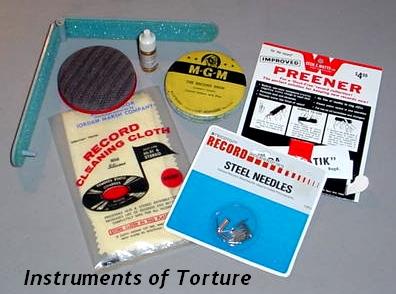
A small industry for marketing cleaning supplies and other accessories grew up around the vinyl record business. Many of these products caused more harm than good.
I’m not going to spend a great deal of time defending my suggestions, some of which are likely to meet with disapproval by certain collectors. I learned a long time ago in Psychology 101 that “Attitude Follows Behavior.” That means once you decide to do something a certain way, and invest a great deal of time and money in that endeavor, it will take heaven and earth to shift your opinion.
I’ll give you just one example. You can buy 2 mil., 3 mil., 4 mil., or 6 mil. poly album sleeves to protect your LP covers. It is understandable that a new collector is going to believe that in buying the more expensive higher mil. he is getting a better product. And after having invested hundreds of dollars to accomodate his collection, it’s not going to be easy to convince him that the 2 mil. product would have been a better choice.
They cost less to buy, less to ship, and offer the same basic protection. Over time, the thicker sleeves become cloudy as tiny scratches build up, a problem that is not nearly as pronounced with the thinner mil. sleeves. Ask yourself this – What are you expecting to get from a 6 mil. sleeve that you won’t get from a 2 mil. sleeve? The additional protection offered by the thicker sleeves is virtually non-existent unless you are expecting your album covers to encounter serious abuse. Even then, any force that will penetrate a 2 mil. sleeve will almost certainly impact the record regardless of the thickness of the poly cover. Nonetheless, there are collectors who won’t buy anything but the 6 mil. sleeves and will be emailing me shortly to tell me why.
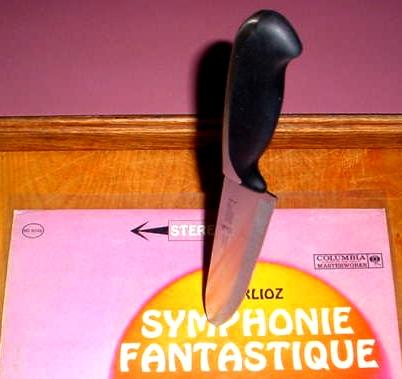
Oh, no! I should have used a 6 mil. sleeve instead of a 2 mil. sleeve!
The question of the correct poly sleeve is just the tip of the iceberg. Should you use a sponge or a brush to clean your records? What type of cleaning fluid should you buy? Should your records be stored flat or upright? Is it a good idea to remove the shrinkwrap from your albums? What is the best inner sleeve? Can a warped record be repaired? (You’ll love some of the methods that have been tested by collectors.) How can I remove stickers, pen marks and soil from my album covers? What are the most important record collecting supplies to consider? What is the safest method to pack and ship vinyl?
I’m going to try and answer these and other questions in the days ahead. In case you hadn’t noticed, I’m getting my apologies out of the way early. From here on in, you’re getting one person’s opinion based on many years of collecting and selling. I have no more excuses or explanations to make.
So, let’s begin with the basic method of how to clean a dirty disc. Just plug in your $2000 VPI Typhoon record cleaning machine or your $10.88 Ronco Record Vacuum and give it a whirl. Oh, you don’t have one of those? Ok, well try this.
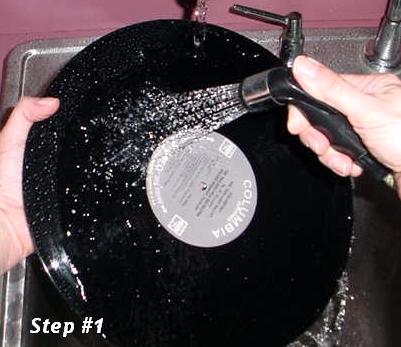
Rinse the record thoroughly under a steady flow of lukewarm water to flush away any loose soil particles that might scratch the disc during cleaning.
Be sure and clean your hands thoroughly when starting, or better still put on a pair of rubber gloves to avoid transferring skin oil to the vinyl. I’ve found that disposable medical industry gloves are efficient and inexpensive. One popular brand is Nitrile, which are non-latex and powder-free. As you can see, we forgot ours today.
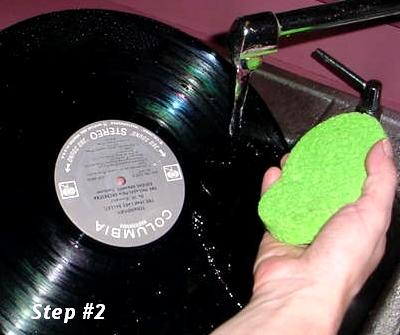
Use a clean sponge and make one circular pass around one side of the record to loosen any hardened surface matter. Rinse the sponge and the record with each pass and repeat as necessary, depending upon how deeply soiled the record is. Repeat on the other side.
By rinsing the sponge and the record with each circular pass you are able to avoid rubbing loose soil particles into the vinyl and causing scratches. Be careful not to rub perpendicular to the grooves. Always clean in a circular motion.
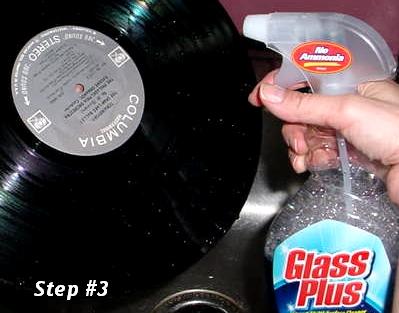
The next step is the deep cleaning stage. While the record is still wet, spray a liberal amount of a glass cleaner directly onto the record. Use the clean sponge and with light to moderate pressure, make 3 or 4 circular paths around the vinyl, then rinse and repeat on the other side.
I use Glass Plus as a record cleaner because I have found that it works best on deep soil and is the only thing I’ve found that gets rid of tar and nicotine stains. If you’ve ever seen a record covered in a strange residue, it was probably the result of a record having been left out for an extended period of time in a house with cigarette smokers. Don’t use a glass cleaner or any product with ammonia on old 78 rpm records as it can damage the record. Soap and water is best for 78s. Glass Plus says it doesn’t have ammonia, but it may have other chemicals that react negatively with the more vulnerable shellac resin.
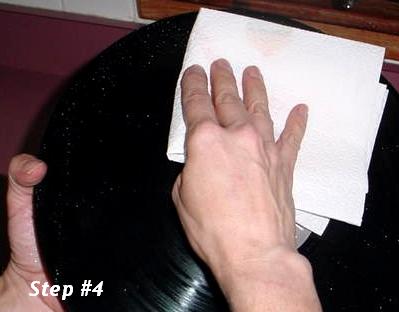
Place the damp record in a clean dish rack and let it drip dry for a few minutes. Then take a clean paper towel, folded for extra thickness, and carefully pat dry the disc.
Allow the record to dry completely, and then put it in a clean, new inner sleeve. Don’t throw away the old sleeve, especially if it is a factory logo sleeve. Tuck it away in the back once you have placed the record in a poly outer sleeve.
I’ve heard some people say never to play a record until it is completely dry, but they never say why. I almost always play a record after I’ve cleaned it, and have never noticed a problem. Obviously, if the record has a high concentration of moisture in the grooves then it may interfere with the sound quality during playback, but it shouldn’t cause any permanent damage.
Final Words: I have been using this method to clean my own records for many years. I’ve tested it on both new and old vinyl. It has not resulted in any damage to my records, and has vastly improved the sound quality of records that had been abused in a previous life. Here are a few additional thoughts on this subject:
1. A few record companies used heavy dies in their paper labels. For example, the London red labels, and many of the early chalky white labels (not the disc jockey / white label promos) will bleed when they are moistened. In most cases the bleeding is so light that it can’t be noticed. However, there are exceptions. Using cooler water will usually lessen the bleeding of these high-dye labels.
2. Make absolutely certain your record is completely dry before attempting to store it away, especially if you are using a polylined inner sleeve. If the record is put away while still damp, it is likely to produce mold.
3. Rinse and replace your cleaning sponge frequently. Keep it someplace safe so no one uses it for anything else. I’ll avoid the temptation to be more graphic.
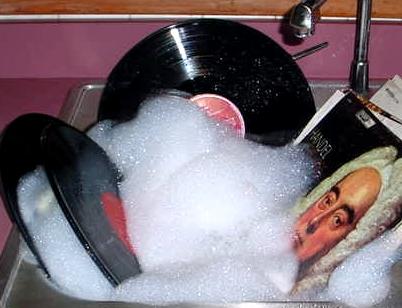
There are many ideas out there on the best way to clean your records. Here is one of them. If you select this option, be sure to keep an eye out for floating labels.


8 Comments:
This may sound like a stupid question, but how do you keep the record labels from getting wet? I'm still learning here, and I want to make sure I do this right.
Thanks!
Tony
Hello Tony. Actually, I addressed this issue to some degree in the article. The only labels that really need concern you are the dark-dyed labels, especially the deep reds and the chalky whites. To the point, brief exposure to water doesn't hurt most LP labels so it's not really a problem. Keep the water cool or warm, but not hot. The only way to efficiently clean records without getting the label wet is by machine.
My first time this site and went to this advice column as my first click. Informative. Made me laff. Great peice of writing. How do I get a membership card, t-shirt,and a bubblehead doll of Bill?
Thanks, Really enjoyed the tips.
Jeff
Your advice on cleaning has worked great for me-but now the big question-is there a way to remove
skips? Even records bought as NM
show up with this problem.
Excellent posting, Bill. Many thanks for the generosity, and the clarity.
That is a nice, gentle looking sponge you have in your photo. What kind is it, and where would you suggest I look for one? Tom
Great and very effective method of cleaning.
Thank you Bill.
Hi there Bill,
I have snuck my dad's picture and white Beatles albums out of his home to frame them. Unfortunately the White Albums are COVERED in nicotine. I mean bad, to where I can feel it. I see you said to use 409, but is there any other way of breaking the tar down faster? Or will I be working on this until Christmas? lol :-) It barely seems like it is making a dent. Thank you so much. I really, really appreciate your help. I have had a difficult time finding information about this online. Have a wonderful day.
Take care,
Melody
Hi there Bill,
I have snuck my dad's picture and white Beatles albums out of his home to frame them. Unfortunately the White Albums are COVERED in nicotine. I mean bad, to where I can feel it. I see you said to use 409, but is there any other way of breaking the tar down faster? Or will I be working on this until Christmas? lol :-) It barely seems like it is making a dent. Thank you so much. I really, really appreciate your help. I have had a difficult time finding information about this online. Have a wonderful day.
Take care,
Melody
Post a Comment
<< Home